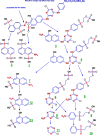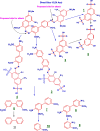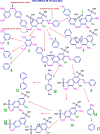Exploring the decolorization efficiency and biodegradation mechanisms of different functional textile azo dyes by Streptomyces albidoflavus 3MGH
- PMID: 38877404
- PMCID: PMC11179346
- DOI: 10.1186/s12866-024-03347-9
Exploring the decolorization efficiency and biodegradation mechanisms of different functional textile azo dyes by Streptomyces albidoflavus 3MGH
Abstract
Efficiently mitigating and managing environmental pollution caused by the improper disposal of dyes and effluents from the textile industry is of great importance. This study evaluated the effectiveness of Streptomyces albidoflavus 3MGH in decolorizing and degrading three different azo dyes, namely Reactive Orange 122 (RO 122), Direct Blue 15 (DB 15), and Direct Black 38 (DB 38). Various analytical techniques, such as Fourier Transform Infrared (FTIR) spectroscopy, High-Performance Liquid Chromatography (HPLC), and Gas Chromatography-Mass Spectrometry (GC-MS) were used to analyze the degraded byproducts of the dyes. S. albidoflavus 3MGH demonstrated a strong capability to decolorize RO 122, DB 15, and DB 38, achieving up to 60.74%, 61.38%, and 53.43% decolorization within 5 days at a concentration of 0.3 g/L, respectively. The optimal conditions for the maximum decolorization of these azo dyes were found to be a temperature of 35 °C, a pH of 6, sucrose as a carbon source, and beef extract as a nitrogen source. Additionally, after optimization of the decolorization process, treatment with S. albidoflavus 3MGH resulted in significant reductions of 94.4%, 86.3%, and 68.2% in the total organic carbon of RO 122, DB 15, and DB 38, respectively. After the treatment process, we found the specific activity of the laccase enzyme, one of the mediating enzymes of the degradation mechanism, to be 5.96 U/mg. FT-IR spectroscopy analysis of the degraded metabolites showed specific changes and shifts in peaks compared to the control samples. GC-MS analysis revealed the presence of metabolites such as benzene, biphenyl, and naphthalene derivatives. Overall, this study demonstrated the potential of S. albidoflavus 3MGH for the effective decolorization and degradation of different azo dyes. The findings were validated through various analytical techniques, shedding light on the biodegradation mechanism employed by this strain.
Keywords: Streptomyces; Azo dyes; Biodegradation; Decolorization; GC-MS; HPLC.
© 2024. The Author(s).
Conflict of interest statement
The authors declare that the research was conducted in the absence of any commercial or financial relationships that could be construed as a potential conflict of interest.
The authors declare no competing interests.
Figures






Similar articles
-
Biodegradation of azo dyes by Aspergillus flavus and its bioremediation potential using seed germination efficiency.BMC Microbiol. 2025 Jan 9;25(1):7. doi: 10.1186/s12866-024-03703-9. BMC Microbiol. 2025. PMID: 39780060 Free PMC article.
-
Characterization and optimization of azo dyes degrading microbes isolated from textile effluent.Sci Rep. 2025 Apr 2;15(1):11241. doi: 10.1038/s41598-025-95359-2. Sci Rep. 2025. PMID: 40175441 Free PMC article.
-
Efficient degradation and detoxification of structurally different dyes and mixed dyes by LAC-4 laccase purified from white-rot fungi Ganoderma lucidum.Ecotoxicol Environ Saf. 2024 Jul 1;279:116450. doi: 10.1016/j.ecoenv.2024.116450. Epub 2024 May 19. Ecotoxicol Environ Saf. 2024. PMID: 38768540
-
Phytoremediation of textile dyes and effluents: Current scenario and future prospects.Biotechnol Adv. 2015 Dec;33(8):1697-714. doi: 10.1016/j.biotechadv.2015.09.003. Epub 2015 Sep 18. Biotechnol Adv. 2015. PMID: 26386310 Review.
-
Streptomyces as a Novel Biotool for Azo Pigments Remediation in Contaminated Scenarios.Front Biosci (Elite Ed). 2024 Sep 19;16(3):29. doi: 10.31083/j.fbe1603029. Front Biosci (Elite Ed). 2024. PMID: 39344382
Cited by
-
Biodegradation of azo dyes by Aspergillus flavus and its bioremediation potential using seed germination efficiency.BMC Microbiol. 2025 Jan 9;25(1):7. doi: 10.1186/s12866-024-03703-9. BMC Microbiol. 2025. PMID: 39780060 Free PMC article.
References
-
- Imron M, Kurniawan SB, Titah H. Potential of bacteria isolated from diesel-contaminated seawater in diesel biodegradation. Environ Technol Innov. 2019;14:100368. doi: 10.1016/j.eti.2019.100368. - DOI
-
- El-Bendary MA, Ezzat SM, Ewais EA, Al-Zalama MA. Optimization of spore laccase production by Bacillus amyloliquefaciens isolated from wastewater and its potential in green biodecolorization of synthetic textile dyes. Prep Biochem Biotechnol. 2021;51:16–27. doi: 10.1080/10826068.2020.1786698. - DOI - PubMed
MeSH terms
Substances
LinkOut - more resources
Full Text Sources
Research Materials
Miscellaneous

